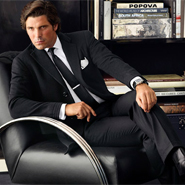- About
- Subscribe Now
- New York,
March 28, 2013

Forty-six percent of affluent men with a household income of more than $250,000 are optimistic or very optimistic about the U.S. economy, while 21 percent of women express the same sentiments, according to a new report from the Shullman Research Center.
The Shullman Luxury and Affluence Monthly Pulse uncovered significant differences in the mindset of high-earning male and female consumers. Luxury marketers that work to sharply target consumers by gender should tap each group's emotional state to effectively showcase products and services.
“Beyond income level, the second most frequently used way of targeting is by gender,” said Bob Shullman, founder/CEO of the Shullman Research Center, New York.
“Women are more emotionally engaged and men are less so,” he said. “If you are a marketer, depending upon whom you are targeting, you need to think about how you describe products, what words you use and the essence of your marketing.”
“One size does not fit all.”
Shullman Research Center’s new survey was conducted online Feb. 26-March 6 among five samples of adult consumers – all household income levels plus four income samples of 250 surveys each as follows: $75,000-$149,999, $150,000-$249,999, $250,000-$499,999 and more than $500,000.
Gender roles
The new report found that men’s and women’s opinions differ on some topics, but are similar in other areas.
While 17 percent of men with a household income of more than $250,000 said that they are very optimistic about the U.S. economy, 4 percent of women said the same.
However, both intend to spend if the economy continues improves is about the same.
Thirty-four percent of men and 32 percent of women plan to spend more.
Also, 54 percent of men and 66 percent of women will spend about the same.
One of the top concerns of both men and women is having enough money saved to retire comfortably since 35 percent of men and 45 percent of women reported this.
The top financial goal for both men and women with a household income of more than $250,000 is to have enough income for retirement.
Notable differences in male and female concerns include their family’s health. Forty-one percent of women and 25 percent of men reported this as a concern.
Rather, 35 percent of men are concerned about the political gridlock in Washington, whereas 24 percent of women reported the same.
Worth 1,000 words
Consumers with a household income of more than $250,000 were previously surveyed on the words that they would use to describe luxury and luxurious.
The new report analyzed these keywords by gender.
Both groups used the words quality, hotel, fancy, nice, money, comfortable, fine, best, cars, expensive and rich.
But women chose words such as house, beautiful, pampered, furs, home, fabric, relaxing, wonderful, quality, cashmere, travel, soft, elegant, love and indulgent whereas men chose words such as value, top, leather, diamonds, waste, overpriced, amenities, happy and Mercedes.
Notably, men were the only group to choose a brand name – Mercedes-Benz.
Shullman Research Center also polled male and female consumers on their luxury buying habits during the last 12 months.
Fifty-nine percent of women and 54 percent of men bought luxury products or services.
The top category for women was premium cosmetics as 15 percent of those surveyed bought from this category in the past 12 months.
For men, the top answer was a piece of jewelry costing $500 or more.
“If your target is women in this high-income group, your creative needs to be targeted to how women think about things and describe them,” Mr. Shullman said.
“Think who you’re really marketing to,” he said. “If it’s women, use more of an engaging type of word, but with men, when you look at those words, they are dispassionate,” he said.
Final Take
Tricia Carr, editorial assistant on Luxury Daily, New York
Share your thoughts. Click here